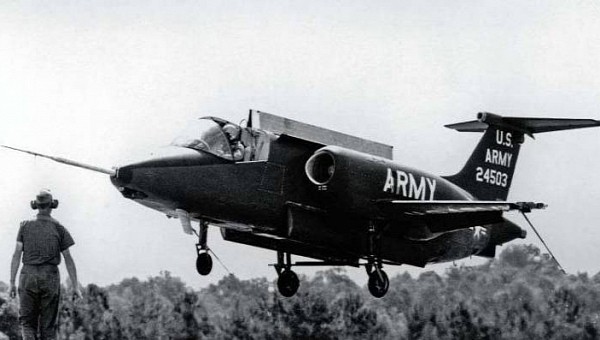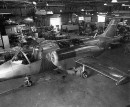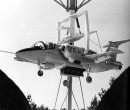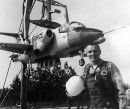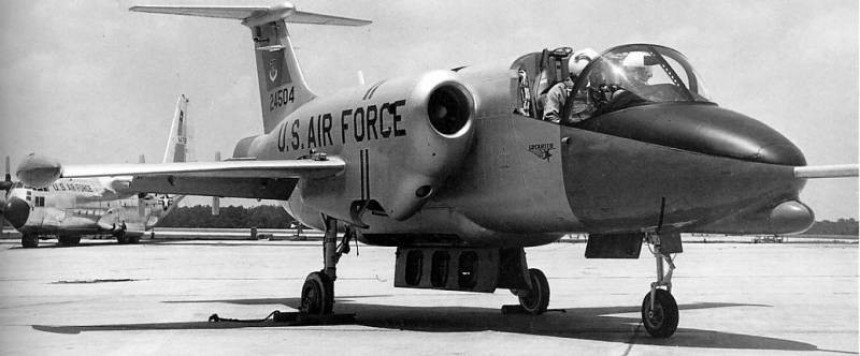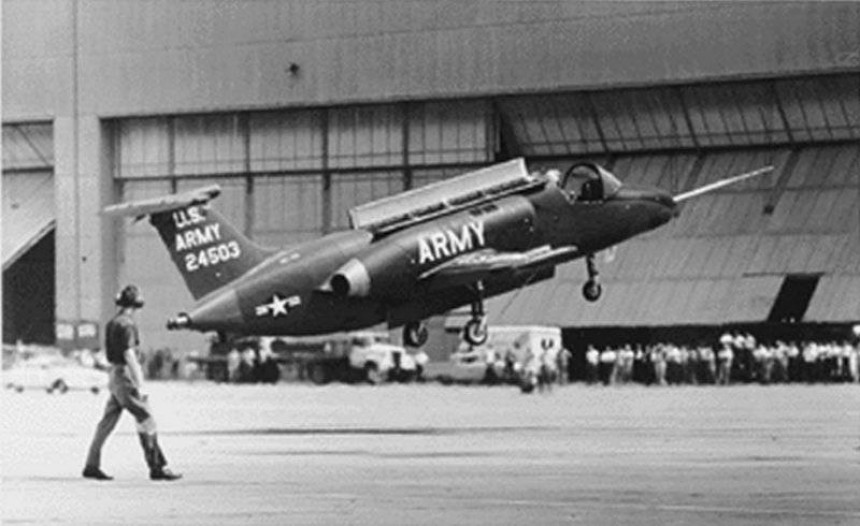What is it about VTOL military airplanes that billion-dollar aerospace companies just can't seem ever to get right? Well, as it happens, making a jet aircraft reliable at vertical takeoff and landing might as well be classified under rocket science. Why? Because in 120 years of powered flight, only one has ever been "successful."
This would, of course, be the Hawker-Siddley Harrier and all its British/American variants. And no, we're not including the F-35B (yet). But this doesn't mean good-intentioned engineers around the world didn't give VTOL the old college try.
There was the Soviet Yakovlev Yak-38, for instance. An airplane so heavy and underpowered that it needed to stop at an airfield to arm up when vertically taking off from aircraft carriers. But even the woeful Yak saw front-line service. Perhaps no VTOL warbird that ever jumped off the blueprints into our mortal reality wasted more time and money for no reward whatsoever than the Lockheed XV-4 Hummingbird.
On the face of it, the Lockheed Hummingbird project indeed had merit in its day. For some context, the group working under the Lockheed Corporation at the turn of the 1960s was perhaps the finest group of engineers in any field, aerospace or otherwise, ever assembled in human history. Think that's hyperbolic? Think again because their resume during this time defies belief.
Be it the F-104 Starfighter, the SR-71 Blackbird, the U-2 Dragon Lady, or the C-130 Hercules cargo transport. There was seemingly nothing but hit after timeless classic hit for Lockheed during the late 50s and early 60s. But the XV-4 Hummingbird was designed nearly at the same time as that list of undisputed icons. The difference is nearly nobody in most modern aviation circles has even heard of it.
So, what gives? What about the XV-4 was so terrible that it's all but forgotten 60 years later. Well, in a way, you could argue the project was doomed by design from the very beginning. Originally proposed to the U.S. Army's Aviation division instead of the U.S. Air Force, the XV-4 was meant to be America's answer to Great Britain's triumph in the Hawker Siddeley P.1127 Kestrel. Aka, what we'd come to know as the original Harrier.
But where the Kestrel's brilliant design used a single engine for both forward and vertical thrust, the XV-4 Hummingbird used an altogether different system for generating lift. Like the not-all-that-spectacular Yak-38, the XV-4 utilized two separate engines for normal flight thrust. In this case, these were two Pratt & Whitney JT12 turbojets most famous for their use in the North American-Rockwell Saberliner, among other applications.
As for strictly-vertical flight, that was delegated to six General Electric J85-GE-19 turbojet engines that, in all aspects other than VTOL flight, were little more than dead weight. As should come as no surprise, this dead weight added by extra VTOL engines was also the Achille's heel of the Soviet Yak-38. Even so, the first flight of the XV-4A took place on July 7, 1962, with a traditional-style rolling takeoff.
Further tethered VTOL tests proved the Hummingbird could at least hover as intended. The aircraft's first free-flight VTOL takeoff occurred in May 1963, with its first in-flight transition from vertical to horizontal flight following soon after. Though initial flight performance could have been better, there was no arguing the Hummingbird was the second most advanced VTOL technology demonstrator in the world behind the Kestrel at the time.
That was, until June 10, 1964, when for reasons that aren't entirely clear, the first XV-4 crashed during test flights over Cobb Country in Northwest Georgia. As a result, the upcoming second Hummingbird prototype, the XV-4B, was radically reworked. Gone were the two JT-12 engines for normal flight. In its place were six General Electric J85s, four for vertical flight and two for horizontal flight.
Though this configuration was slightly slower than the now-destroyed XV-4A, it was hoped that it would at least be substantially more stable. Well, one can only wonder if Lockheed ever made that determination. Because on top of seemingly endless electrical and wiring issues, the XV-4B crashed during testing in March 1969, yet again over the state of Georgia. The pilot, Harlan J. Quamme, was able to escape via his ejection seat, but the second and final XV-4 Hummingbird was lost entirely in the incident.
Coincidentally, the first production variants of the Hawker Siddeley Harrier would go into service only a month after the demise of the second XV-4. From then on, the U.S. Military was forced to come to a near-unprecedented realization. At least when it came to VTOL military warbirds, the British far outclassed both the Soviets and the Americans.
Until 2022, the U.S. Military's most prevalent VTOL jet aircraft was the AV-8B, itself a license-built copy of the Harrier II. The successor airplane to the original Harrier Jump Jet, which kicked the snot out of the XV-4 Hummingbird in the first place.
Check back soon for more from Celebration Month 2022 here on autoevolution.
There was the Soviet Yakovlev Yak-38, for instance. An airplane so heavy and underpowered that it needed to stop at an airfield to arm up when vertically taking off from aircraft carriers. But even the woeful Yak saw front-line service. Perhaps no VTOL warbird that ever jumped off the blueprints into our mortal reality wasted more time and money for no reward whatsoever than the Lockheed XV-4 Hummingbird.
On the face of it, the Lockheed Hummingbird project indeed had merit in its day. For some context, the group working under the Lockheed Corporation at the turn of the 1960s was perhaps the finest group of engineers in any field, aerospace or otherwise, ever assembled in human history. Think that's hyperbolic? Think again because their resume during this time defies belief.
Be it the F-104 Starfighter, the SR-71 Blackbird, the U-2 Dragon Lady, or the C-130 Hercules cargo transport. There was seemingly nothing but hit after timeless classic hit for Lockheed during the late 50s and early 60s. But the XV-4 Hummingbird was designed nearly at the same time as that list of undisputed icons. The difference is nearly nobody in most modern aviation circles has even heard of it.
But where the Kestrel's brilliant design used a single engine for both forward and vertical thrust, the XV-4 Hummingbird used an altogether different system for generating lift. Like the not-all-that-spectacular Yak-38, the XV-4 utilized two separate engines for normal flight thrust. In this case, these were two Pratt & Whitney JT12 turbojets most famous for their use in the North American-Rockwell Saberliner, among other applications.
As for strictly-vertical flight, that was delegated to six General Electric J85-GE-19 turbojet engines that, in all aspects other than VTOL flight, were little more than dead weight. As should come as no surprise, this dead weight added by extra VTOL engines was also the Achille's heel of the Soviet Yak-38. Even so, the first flight of the XV-4A took place on July 7, 1962, with a traditional-style rolling takeoff.
Further tethered VTOL tests proved the Hummingbird could at least hover as intended. The aircraft's first free-flight VTOL takeoff occurred in May 1963, with its first in-flight transition from vertical to horizontal flight following soon after. Though initial flight performance could have been better, there was no arguing the Hummingbird was the second most advanced VTOL technology demonstrator in the world behind the Kestrel at the time.
Though this configuration was slightly slower than the now-destroyed XV-4A, it was hoped that it would at least be substantially more stable. Well, one can only wonder if Lockheed ever made that determination. Because on top of seemingly endless electrical and wiring issues, the XV-4B crashed during testing in March 1969, yet again over the state of Georgia. The pilot, Harlan J. Quamme, was able to escape via his ejection seat, but the second and final XV-4 Hummingbird was lost entirely in the incident.
Coincidentally, the first production variants of the Hawker Siddeley Harrier would go into service only a month after the demise of the second XV-4. From then on, the U.S. Military was forced to come to a near-unprecedented realization. At least when it came to VTOL military warbirds, the British far outclassed both the Soviets and the Americans.
Until 2022, the U.S. Military's most prevalent VTOL jet aircraft was the AV-8B, itself a license-built copy of the Harrier II. The successor airplane to the original Harrier Jump Jet, which kicked the snot out of the XV-4 Hummingbird in the first place.
